Seeking Effective Solutions for Jassa-Induced Biofouling on Saccharina latissima
-
IMG_3641Hello everyone,
I’m Alexis, a seaweed farmer based in northern Brittany, France. We cultivate Saccharina latissima on a 6-hectare offshore site.
We’re encountering a recurring issue with biofouling caused by amphipods of the genus Jassa, which build their habitats on the kelp, complicating the cleaning process.
Simple rinsing with water isn’t sufficient to remove these biofoulers. I’m seeking effective solutions to facilitate the cleaning of the harvest, whether at sea or on land.
Have any fellow seaweed farmers tested and approved specific methods or equipment to manage this type of biofouling?
I’m also open to recommendations on tools or techniques that could help address this problem.
Thank you in advance for your insights and advice.
Best regards,
Alexis
@alexis_35 thank you for sharing this query. I am just starting in the seaweed farming business, but I have a botanical/ecological background. From that perspective, I would suggest looking into the factors that affect the population dynamics of these species. Temperature, salinity, and light are factors that affect the concentration of these amphipods. So maybe there are opportunities for experimenting with the depth or layout of your design to see if something could change? Also, the natural biological controls of these grazing crustaceans are bigger animals, including fish. I am wondering: could larger fish populations affect the density of Jassa spp. in your seaweed farm? I know fish farms are increasingly using seaweed (and related parasites) as a feed source... (attaching some potentially helpful literature). Cheers!
Jassa (Crustacea: Amphipoda): a new morphological and molecular assessment of the genus
Use of Algae in Aquaculture: A Review
water-12-02429
@jc_87
 your input is incredibly helpful as we keep working on solutions!
your input is incredibly helpful as we keep working on solutions!
Hi @jc_87, @lindsay_olsen, @kendall_barbery, and @loretta_roberson,
Thank you all so much for your thoughtful replies and the time you took to help with our biofouling issue. we really appreciate your insights.
@jc_87 We’ve experimented with different line depths between 0 and 5 meters below the surface, but unfortunately haven’t seen any reduction in Jassa colonization. Just for context, the site has a tidal range of 14 meters, with about 10 meters of water at low tide during spring tides. As for fish populations helping control Jassa, that’s an intriguing idea. I honestly don’t know, but it seems worth looking into further.
@lindsay_olsen Yes, we are considering harvesting earlier in the season, although our early seeding trials this year didn’t give great results. Unfortunately, trimming the blade tips isn’t a viable option for us since the biofouling appears along the entire length of the kelp. I’ll attach more pictures showing this on larger blades to give a better sense of it.
@kendall_barbery Thanks for your interest in the site conditions. Salinity is around 34.5 ‰, and at low tide during spring tides, we have 10 meters of water depth. The site has strong currents (>5 knots during spring tides) and turbidity is high, with visibility ranging from 1 to 7 meters depending on the time of year. This is our first season cultivating, but my partner has been running this farm for two years. Jassa was present last year, though less abundantly. The amphipods seem to show up shortly after the lines go in, but we see the biggest blooms toward the end of the growing season.
@loretta_roberson We’ve tested several manual brushes, but they weren’t very effective. A rubber spatula worked a bit better (though still exhausting), and a rotating mechanical brush with plastic bristles has shown the most promise so far. We’re thinking a moderate-pressure seawater rinse combined with the mechanical action could be ideal, still need to trial that setup. The farm is well exposed to swell and currents, but we hadn’t thought about using extra buoys to increase line movement, that’s a great suggestion, thank you! And yes, all gear will be removed and cleaned post-harvest to reset things.
Thanks again everyone!!!
Best,
Muriel & Alexis
@jc_87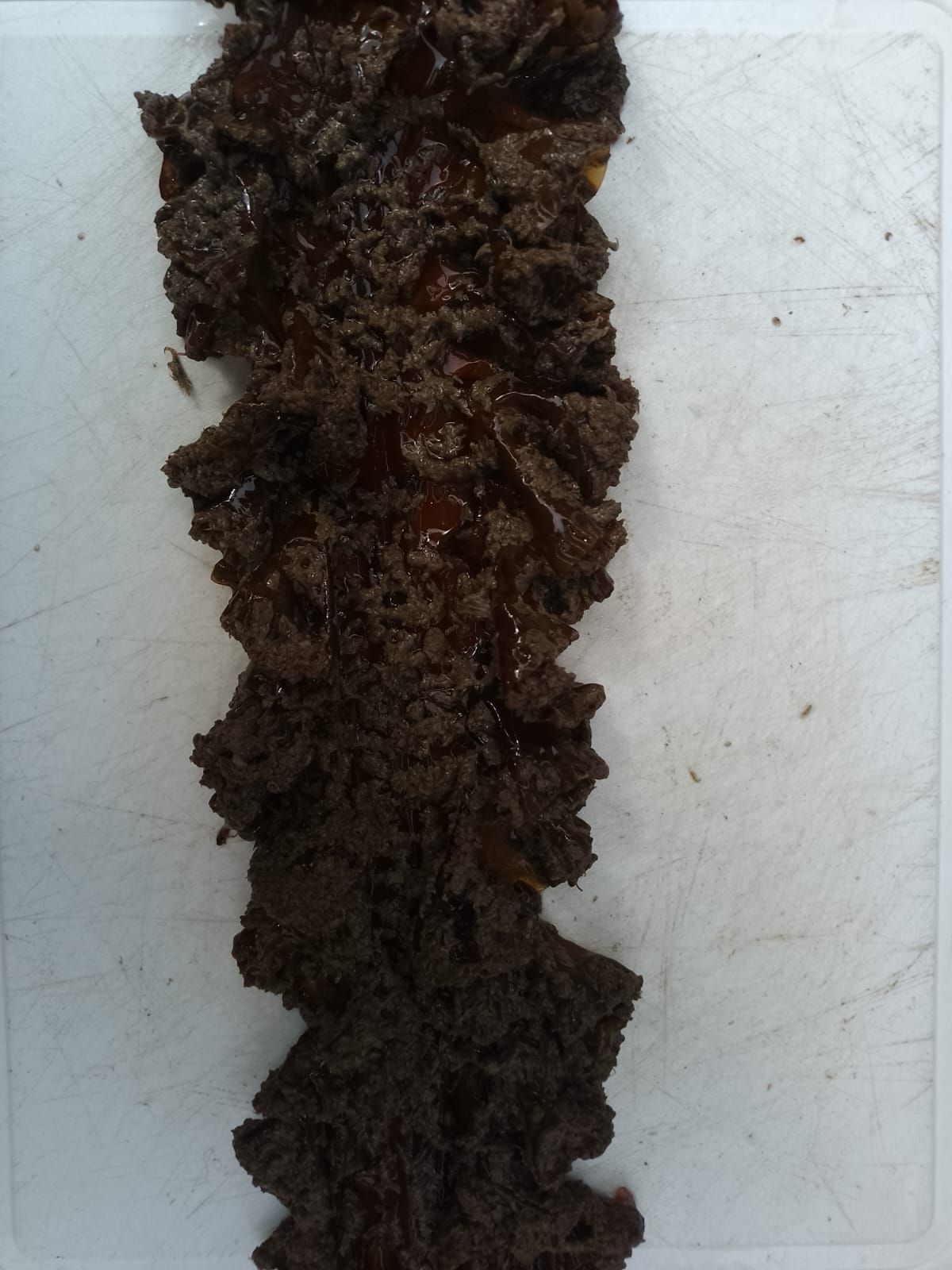
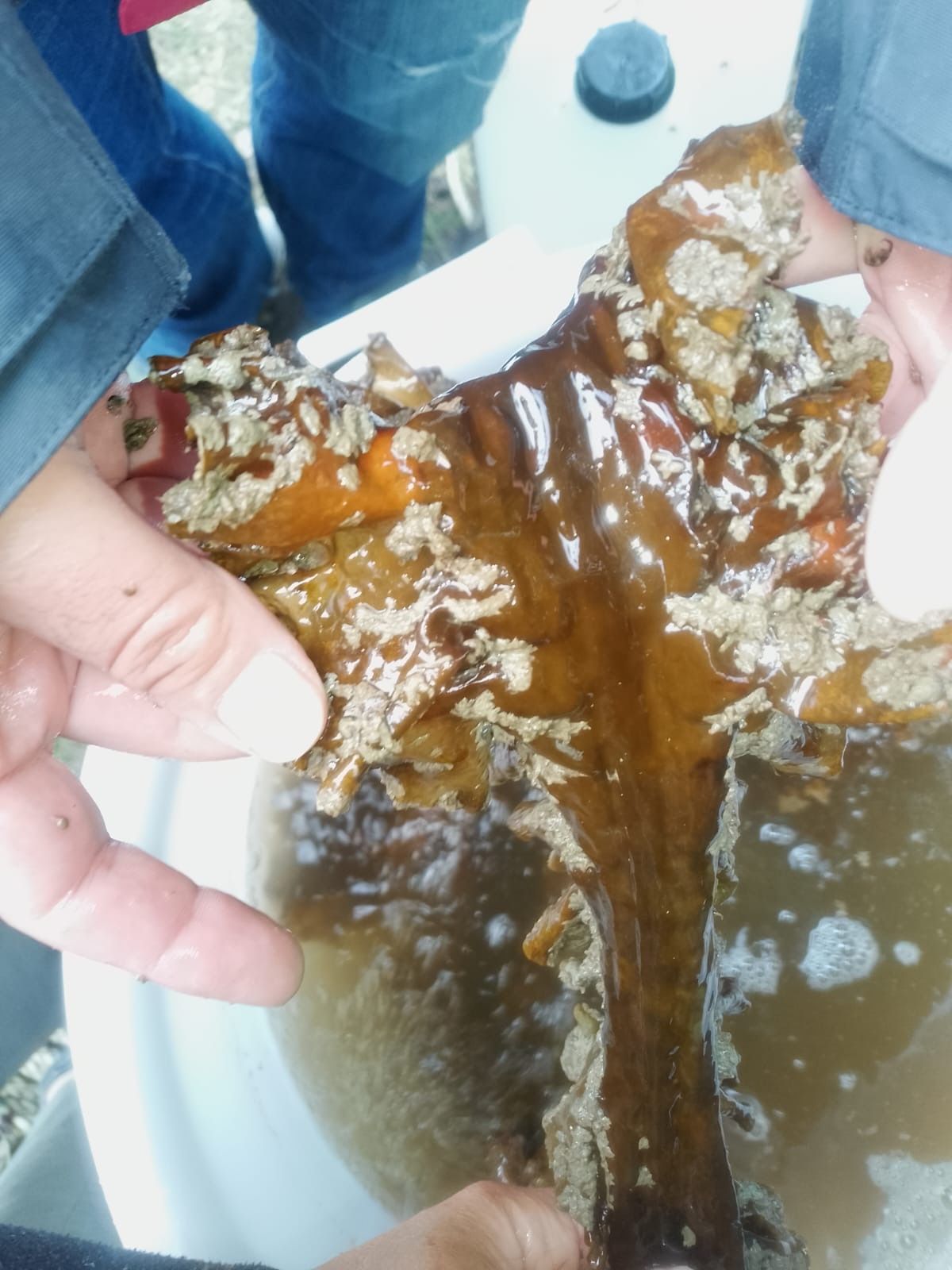
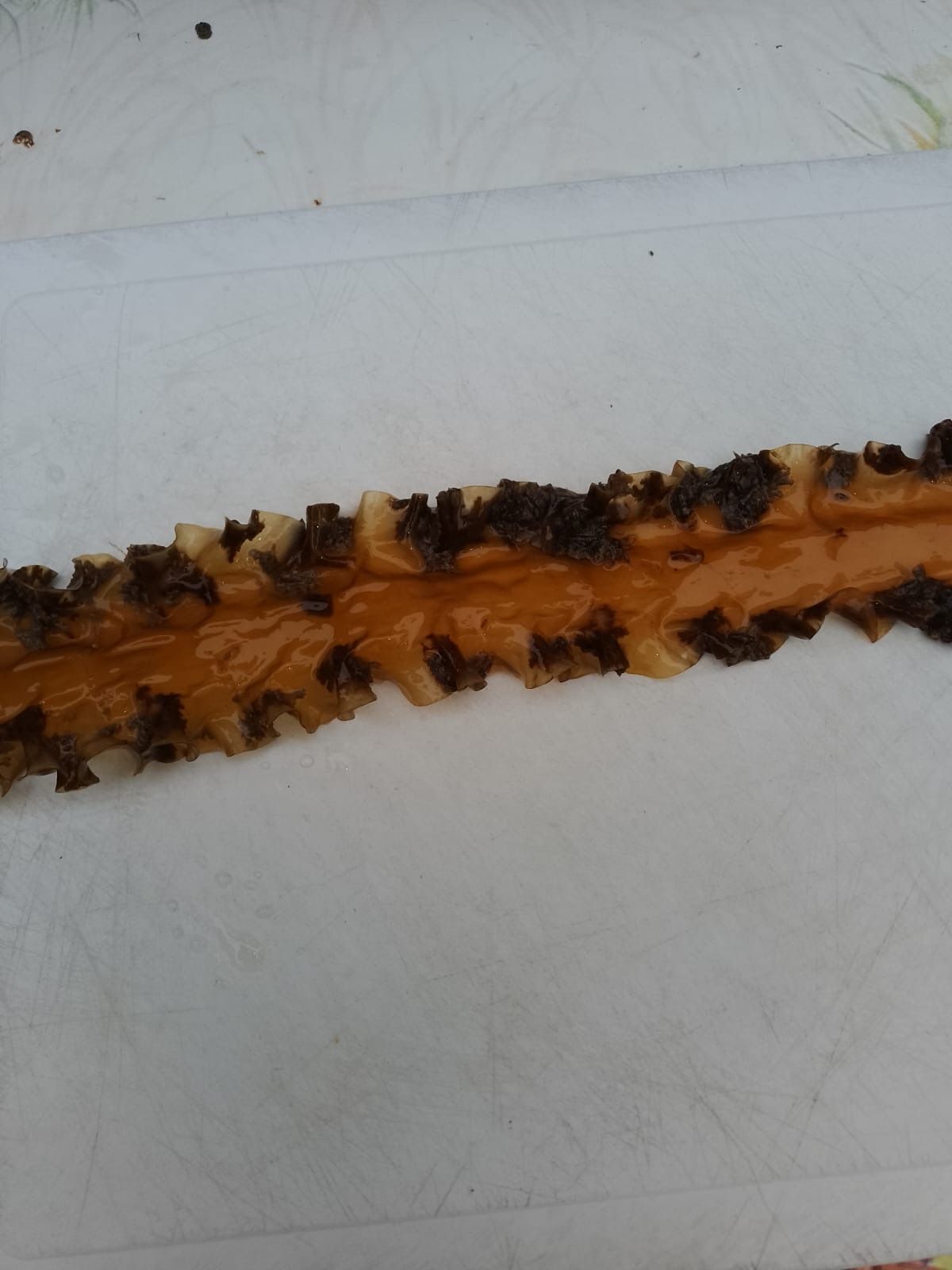
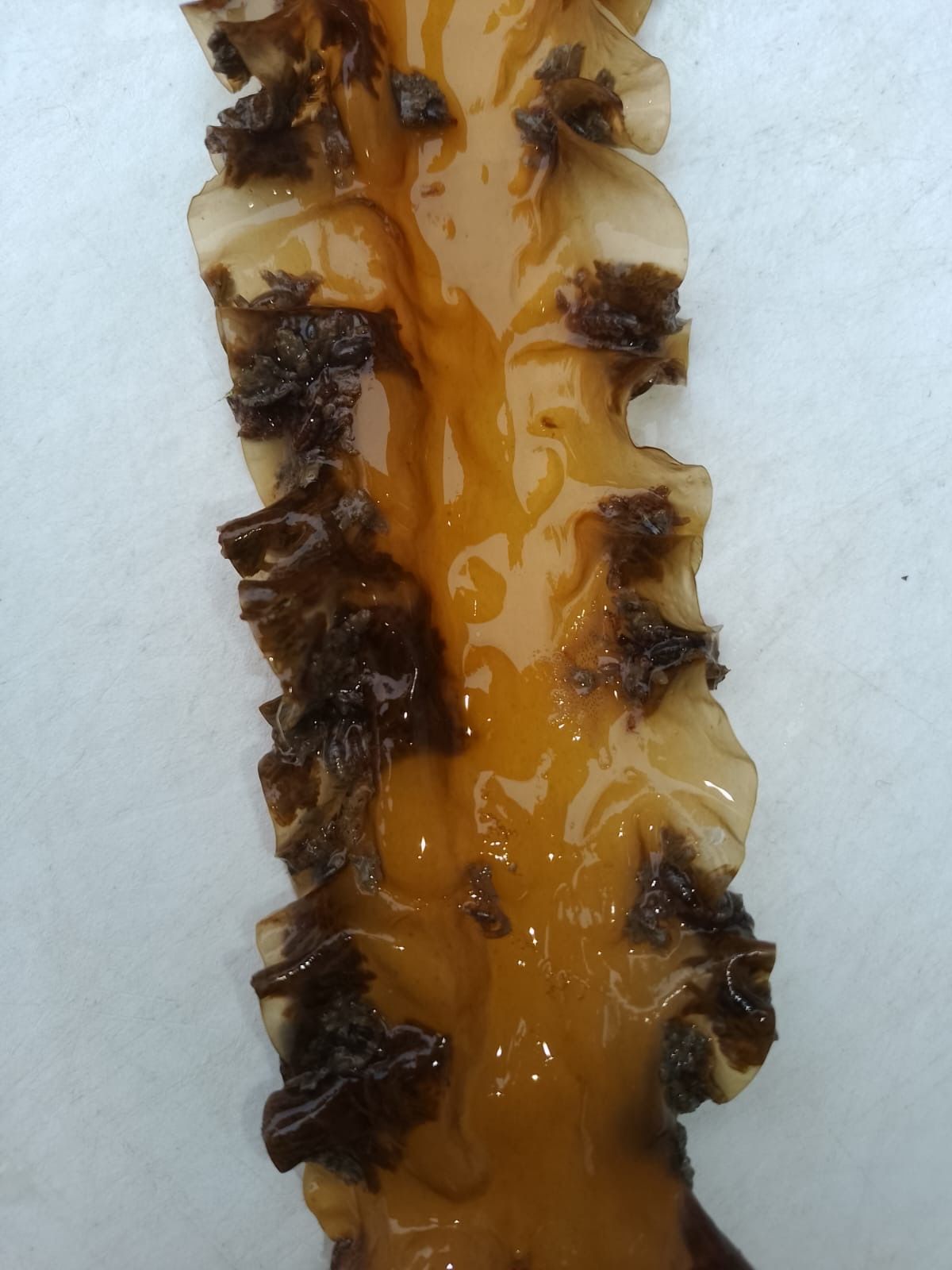
@alexis_35 Hi Alexis,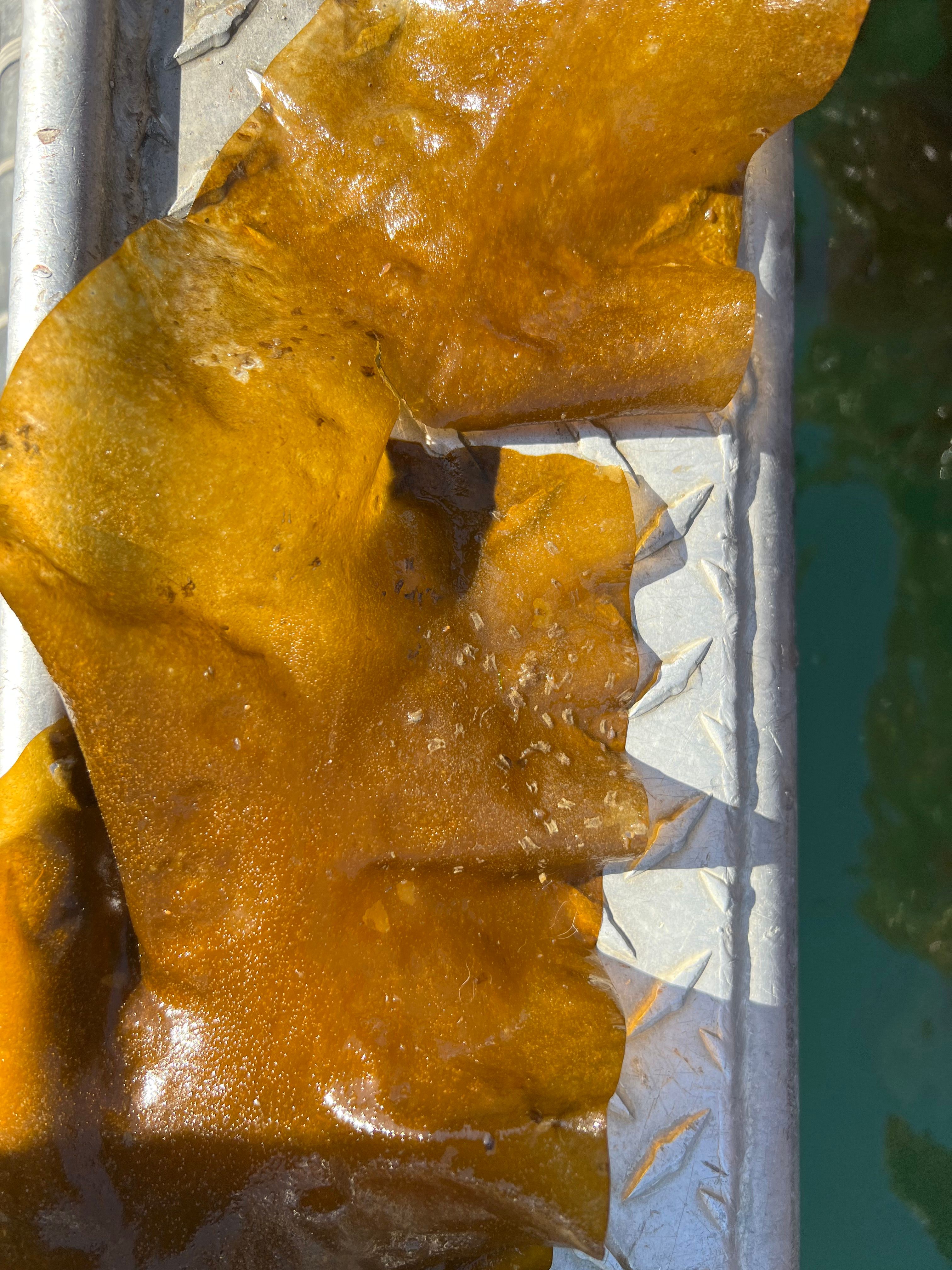
We get something similar on my farm in Kachemak Bay, Alaska. Attaching an image here, but we see the egg casings towards the bottom tips of the blade, and the animals themselves up in the holdfast area. I haven't had great luck removing the egg casings with washing, so we tend to trim the part of the blade at the bottom end to remove them for food-grade sales. It looks like that might not be an option for you. We have also found that if we harvest earlier (early April as opposed to mid-May) the prevalence is much more minimal. @tiffany_stephens @schery_umanzor I know you've spent some time thinking about kelp diseases / afflictions -- any advice here?
Good luck!
Lindsay
@alexis_35 Hi, Alexis. Thanks for sharing the video. Following @jc_87's insights, would you be willing to share some information about your site, such as salinity, depth (water depth and longline depth), and turbidity/visibility? Is this the first season you have noticed the amphipods? And do you know what the water temperature and water quality conditions were when they first started to appear?
@alexis_35 Those tube-dwelling amphipods are common from Woods Hole down to Puerto Rico where I have worked mostly with red seaweeds. On some of the finer-branched species it was challenging to remove, but we used a brush like the attached (~50 cm long, bristles 5 cm) on thicker specimens that worked well. We had them settling on the growlines and it helped to clean those with a scraper. It does seem very site specific because in some nearby areas, we see hardly any (particularly in areas closer to shore where fish are abundant @jc_87 !). Also, how much the farm gear is moving around so maybe some additional buoys on the growlines can introduce that? Once you get them, though, you might need to wait until winter or remove everything and clean to get rid of them. I still find dried amphipods in my dive gear. Good luck!
@loretta_roberson
 your input is incredibly helpful as we keep working on solutions!
your input is incredibly helpful as we keep working on solutions!
Hi @jc_87, @lindsay_olsen, @kendall_barbery, and @loretta_roberson,
Thank you all so much for your thoughtful replies and the time you took to help with our biofouling issue. we really appreciate your insights.
@jc_87 We’ve experimented with different line depths between 0 and 5 meters below the surface, but unfortunately haven’t seen any reduction in Jassa colonization. Just for context, the site has a tidal range of 14 meters, with about 10 meters of water at low tide during spring tides. As for fish populations helping control Jassa, that’s an intriguing idea. I honestly don’t know, but it seems worth looking into further.
@lindsay_olsen Yes, we are considering harvesting earlier in the season, although our early seeding trials this year didn’t give great results. Unfortunately, trimming the blade tips isn’t a viable option for us since the biofouling appears along the entire length of the kelp. I’ll attach more pictures showing this on larger blades to give a better sense of it.
@kendall_barbery Thanks for your interest in the site conditions. Salinity is around 34.5 ‰, and at low tide during spring tides, we have 10 meters of water depth. The site has strong currents (>5 knots during spring tides) and turbidity is high, with visibility ranging from 1 to 7 meters depending on the time of year. This is our first season cultivating, but my partner has been running this farm for two years. Jassa was present last year, though less abundantly. The amphipods seem to show up shortly after the lines go in, but we see the biggest blooms toward the end of the growing season.
@loretta_roberson We’ve tested several manual brushes, but they weren’t very effective. A rubber spatula worked a bit better (though still exhausting), and a rotating mechanical brush with plastic bristles has shown the most promise so far. We’re thinking a moderate-pressure seawater rinse combined with the mechanical action could be ideal, still need to trial that setup. The farm is well exposed to swell and currents, but we hadn’t thought about using extra buoys to increase line movement, that’s a great suggestion, thank you! And yes, all gear will be removed and cleaned post-harvest to reset things.
Thanks again everyone!!!
Best,
Muriel & Alexis
@jc_87
 your input is incredibly helpful as we keep working on solutions!
your input is incredibly helpful as we keep working on solutions!
Hi @jc_87, @lindsay_olsen, @kendall_barbery, and @loretta_roberson,
Thank you all so much for your thoughtful replies and the time you took to help with our biofouling issue. we really appreciate your insights.
@jc_87 We’ve experimented with different line depths between 0 and 5 meters below the surface, but unfortunately haven’t seen any reduction in Jassa colonization. Just for context, the site has a tidal range of 14 meters, with about 10 meters of water at low tide during spring tides. As for fish populations helping control Jassa, that’s an intriguing idea. I honestly don’t know, but it seems worth looking into further.
@lindsay_olsen Yes, we are considering harvesting earlier in the season, although our early seeding trials this year didn’t give great results. Unfortunately, trimming the blade tips isn’t a viable option for us since the biofouling appears along the entire length of the kelp. I’ll attach more pictures showing this on larger blades to give a better sense of it.
@kendall_barbery Thanks for your interest in the site conditions. Salinity is around 34.5 ‰, and at low tide during spring tides, we have 10 meters of water depth. The site has strong currents (>5 knots during spring tides) and turbidity is high, with visibility ranging from 1 to 7 meters depending on the time of year. This is our first season cultivating, but my partner has been running this farm for two years. Jassa was present last year, though less abundantly. The amphipods seem to show up shortly after the lines go in, but we see the biggest blooms toward the end of the growing season.
@loretta_roberson We’ve tested several manual brushes, but they weren’t very effective. A rubber spatula worked a bit better (though still exhausting), and a rotating mechanical brush with plastic bristles has shown the most promise so far. We’re thinking a moderate-pressure seawater rinse combined with the mechanical action could be ideal, still need to trial that setup. The farm is well exposed to swell and currents, but we hadn’t thought about using extra buoys to increase line movement, that’s a great suggestion, thank you! And yes, all gear will be removed and cleaned post-harvest to reset things.
Thanks again everyone!!!
Best,
Muriel & Alexis
@loretta_roberson
 your input is incredibly helpful as we keep working on solutions!
your input is incredibly helpful as we keep working on solutions!
Hi @jc_87, @lindsay_olsen, @kendall_barbery, and @loretta_roberson,
Thank you all so much for your thoughtful replies and the time you took to help with our biofouling issue. we really appreciate your insights.
@jc_87 We’ve experimented with different line depths between 0 and 5 meters below the surface, but unfortunately haven’t seen any reduction in Jassa colonization. Just for context, the site has a tidal range of 14 meters, with about 10 meters of water at low tide during spring tides. As for fish populations helping control Jassa, that’s an intriguing idea. I honestly don’t know, but it seems worth looking into further.
@lindsay_olsen Yes, we are considering harvesting earlier in the season, although our early seeding trials this year didn’t give great results. Unfortunately, trimming the blade tips isn’t a viable option for us since the biofouling appears along the entire length of the kelp. I’ll attach more pictures showing this on larger blades to give a better sense of it.
@kendall_barbery Thanks for your interest in the site conditions. Salinity is around 34.5 ‰, and at low tide during spring tides, we have 10 meters of water depth. The site has strong currents (>5 knots during spring tides) and turbidity is high, with visibility ranging from 1 to 7 meters depending on the time of year. This is our first season cultivating, but my partner has been running this farm for two years. Jassa was present last year, though less abundantly. The amphipods seem to show up shortly after the lines go in, but we see the biggest blooms toward the end of the growing season.
@loretta_roberson We’ve tested several manual brushes, but they weren’t very effective. A rubber spatula worked a bit better (though still exhausting), and a rotating mechanical brush with plastic bristles has shown the most promise so far. We’re thinking a moderate-pressure seawater rinse combined with the mechanical action could be ideal, still need to trial that setup. The farm is well exposed to swell and currents, but we hadn’t thought about using extra buoys to increase line movement, that’s a great suggestion, thank you! And yes, all gear will be removed and cleaned post-harvest to reset things.
Thanks again everyone!!!
Best,
Muriel & Alexis
@jc_87



@alexis_35 more feedback from @schery_umanzor who said "those casing belong to grammarids. They are small crustaceans around year round. Once they settle, they colonize areas pretty quickly. How to prevent them? Can’t, really. Not in an open environment. We get them from time to time on our tanks. We discard them by cleaning the system. Farms offer new areas to colonize so is hard to recommend “ harvest earlier” because this guys are usually around."